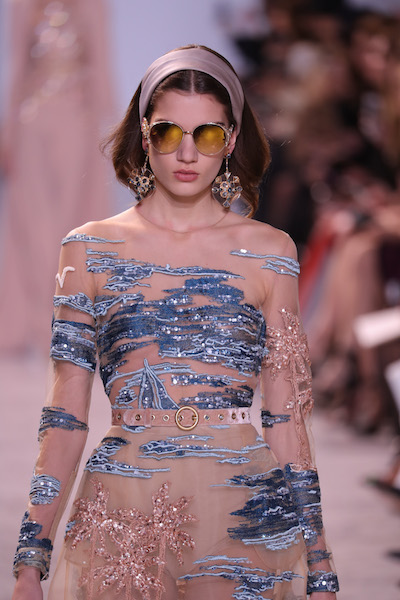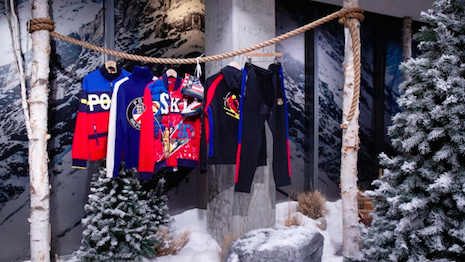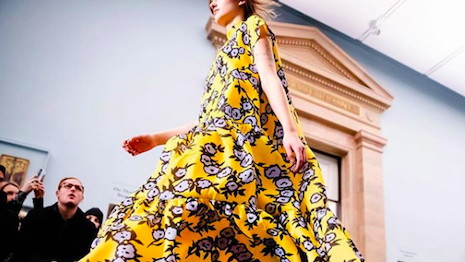As fashion week turns more consumer facing, luxury marketers have become influencer-focused for these events. But while their reach is not slowing down, this year one stood out more so than others.
Launchmetrics produced a report on the trends driving fashion week across the world, but it was the influence of The Blonde Salad creator Chiara Ferragni that was the most prolific. Ms. Ferragni, along with other influencers and celebrities, was able to boost media value for the brands who she posted about, signifying that fashion week is now a consumer-facing event.
“In fashion today everyone is quite aware of the influencer effect and the value these content creators bring to brands," said Alison Bringé, chief marketing officer at Launchmetrics, London. "That said, I was quite surprised with the sheer power and reach of Chiara Ferragni.
"In a phenomenon we are now dubbing the #ChiaraEffect, this all-star influencer was able to achieve over $18 million Media Impact Value during fashion week last season," she said. “This figure ranks even higher than the entire media impact value of the Chanel show as well as many other renowned brands."
Fashion Week influence
While music artist Nicki Minaj also generated significant engagement for New York and Milan Fashion Week and Victoria Beckham did the same for London, it was more common for brands showing at Paris Fashion Week to target the Asian market. South Korean rapper Jennie Kim produced the top post during Paris for the Chanel show.
 A model walks the runway during the Elie Saab Haute Couture Spring Summer 2017 show as part of Paris Fashion Week. Image credit: Antonio de Moraes Barros Filh
A model walks the runway during the Elie Saab Haute Couture Spring Summer 2017 show as part of Paris Fashion Week. Image credit: Antonio de Moraes Barros Filh
Another South Korean music artist, Lee Chae-rin, followed Ms. Kim, with the second most engaging post while attending the Celine show.
Launchmetrics also found that publications saw the highest media impact value from its paid placements, showcasing the growth of the public’s interest in fashion and fashion week.
Now that fashion week is fully integrated with consumer interest, brands who are taking on 360-degree strategies are seeing positive results, and social media is the most result-driven platform. However, it is not the brands who post the most that see the highest engagement.
Fashion brands who focus on leveraging influence in target audiences will see the best results.
Ralph Lauren generated significant buzz through influencers across the gamut for its 50th anniversary show, which included an impressive 100 looks. Influencers reflected varied niches such as politics, fashion, television and film.
 Ralph Lauren's pop-up at Fred Segal. Image credit: Ralph Lauren
Ralph Lauren's pop-up at Fred Segal. Image credit: Ralph Lauren
Anna Wintour, Hilary Clinton, Oprah Winfrey, Robert De Niro, Donna Karan and Calvin Klein were amongst those Ralph Lauren tapped to share their voices.
However, designer Victoria Beckham generated similar results mostly through her own social channels, as she is a celebrity herself, and saw buzz regarding the move of her show from New York to London.
Giorgio Armani was able to generate hype for its ready-to-wear line thanks to its impressive show, including a music performance and setting at the hangar of Milan’s Linate Airport.
Consumer facing events
As consumers become more interested in fashion week, companies are learning to leverage this.
London Fashion Week is becoming more consumer-centric with the launch of a new event format.
The British Fashion Council is working with BBC Earth and fashion designer Amy Powney to put on London Fashion Week: Insiders, which gives consumers access to see-now, buy-now shows, talks and other experiences. In recent years, fashion week has evolved from an event primarily geared towards trade to a spectacle for all fans, leading to new types of experiences (see story).
Another new experience offered a behind-the-scenes look at retailers and brands this September.
During New York Fashion Week in September, Fashion Week Store Tours provided an informative and all-inclusive look into various important locations for fans. Guests can tour various areas of New York with a guiding expert to get an idea of brands' innovations (see story).
“Last year we released our first study of the various fashion weeks across New York, London, Paris and Milan,” Ms. Bringé said. “After analyzing the data, it became quite clear that these events were no longer just about the industry, but a global platform to reach the digital-savvy consumer.
“The key takeaways in this year’s report are that brands need to think beyond the runway when organizing their shows to ensure they maximize ROI and create programs that build buzz after the events ends,” she said. “The case studies within the report shed light on how brands can generate media impact through activities such as leveraging influencers to create 360-degree campaigns, changing their show cities to connect to new consumers and markets, or even by focusing on their owned media to increase share of wallet.”
{"ct":"iRlSJl3oJ2iCoU8u9sMbrkrDY8dz+3YskwMpeRL\/xfWTUt4gAxctKyvQzhonE9k7bp23M7uKpjyflC4PpFzRh7Jx1BxvHN6YwTbRu\/RHu5\/B6nkawMNkaQph8Tqde2tgKL3\/jnKdhFQjjCNMVkgEChpvRfBlX7h2wrTe2TpNIjws2lCGIk\/fmIfXjdS2K8a3zSqjZoHBbrRjMUIcJ12\/GIq5Ln3YnBYp3l1GFJGB\/Mg9nINTM0kFKCyoCXOal0Z54J\/UzCWUx65Q2Ic3Pgo9UfeHYNIcqTkyL\/h\/i4XRae2eEZ9zeOK5T2L0UFNtoQaTkDqdyzthQXCZnX+t\/NvTLx091u0DUnGPLXh8ix4+VvrzIAWZqk8GWo3RSv+73QPY7fdMoNRxj3gH7ELbiYbmzG8Zn8TvKNnMgwQ+ooMKQj4rCRaldkh\/HAYEqwSbwoMcFEb76sRQT9H8\/VqBUqtVLQPr7lKlzxetHWUqp7Uq8aw+gV8v2dydMrsq3UlWW6W6IzOy3UHFv2SzCH8I6JrWyl1Br5bTDIsRLfa1qUzYTu3UFTWW4UqVtPop2Zv1uohl96he9qW\/iUMquASrl5dvsl+\/j0kbKy2Xhq7pQSFoUc3DkxRmcvZg1NKSz5B6TQdB98FeuhP7YzQdc4ILGVdQKYUmA2+AgAOv28FNnS+Zvis6neVbLbLb144uWxqmktmBQBL\/FAkgLRVI6osadHGydD6CJwclHl3lnWaQWIrU6Qijgc6KQCUdFONjVo1SLtS9U3brhaDfinenuUbmupbbV+PuZLmjb2qKuJaAKEhFE+n2rmp9KIXIAHP51itoLr1NJyYQJeMTXWPCO054Tfn2nY3uzRi0nCx8cvdchQ+1fPJ2qkfv1y8JRPYhXw+oSOLqLGjvFkVrnyi2r5QUbGrn26LGyuJfjL3NLlQJSQuPzd2kDT\/tXLhh9ZKOivSupowCT6ibNTJBKzmW2AdAGe1RpFiYlxT9Bzvds0EKiQry2fXjWG+cTIZo1JTHkhXMTJH\/voGT+YFsnSrp090mrIfp5rCckHQyKqvEoRj\/Kjf+rfunU5FOpEh0GjW0HmIAapmNDt9cxx2NK8GsDNyNz6\/0+1xFBweoRthxNuOvOQSwY\/aiXGps53Y\/KU+BrMbH2h\/50zVycFNurUAaUuxk3KmqasgRA+Oww\/skKxGctnygj6bp+MRq+2nO+taaYYxQALtBTyAL76IxU2IeJmaUbA6BWZ9iags6sUy+l\/Xv+VTSRr7rYX7+FJmsRPIMvrTOpRwkLvOkbXXgEmo1540qvHHYOHws8TJxWxzu+r3ygTJtDjR4rx1LaV4wFg7UYhkitPMIFV97KzcKtnxaORtaoO2Qz4F976gKWbbJ6EkxJhoq8X8ZV7RYLx+N\/VUBGAmhIyljSyjjp3hUW7Hszz1yWBTfW19sQjfkelplQNnDSVRpnfs46shCQ87jJk95Z\/Gx2o+eqSINPcLWJ98XEq5rypk8jejae2rEJZty0LoQ9p\/Tu0hhXqNxalrHmO+dzQ1Wgph131JZ65XfGfbPijoUkXpPSZuV1Jut2uvvT9NMqqDg033Pa1relcVlCZIgZRVYhYdXdsBUcPqHCGCrsCAtrU8e0LcjnOIOxAW6X+Mst9sbFe2HWpTURrYK4rjsVORC0LGFUC7w0B3M9qShJ1yG\/A3gOlWori30a3aIXb8N2Bdtl2eQbLiCGDWOpiG7sZj5NAOjSuGAcb8b3ZPH03jOyobe69SO1mz88gSZBw2vdJif7LaJomg7gpyksGAGyQj9smlxZsrqxBjQmk0YqDbYMB6OWlWkv9Rm9Yt9TnumvclGQcUypx7SU6t8N6XBZ4W5Gw+4kYMKhzqlBFFvfjQ0N+6zyYpEpW2sxveNkSrhUv684Mnq+4xBTyrH\/thlUKBArCrMR43DV1qQE5jL+t82S81YM9wU6L27ANrj1Pns3dlsx+Y+Ytq\/nCokvmev5Zp+t2Kb3ypi0JE3AVIhFlf\/LUmtqziVlBd3MaaqPIAcxUa0XC1e\/6LJZFE2LB3ZX9mLF5O5NEa9TteGJXT6\/ZzWBHf9pHWUZryw2elZttMvR8tiU8kAk+t\/DQlcXXTgr06VK6tUwWTmsRsp4D5t+iwf+8OfNLHaD12vjBLvh1lAAiStwl89egVVrHvJ9B\/cRPU3TZg19+GUwaXyp2UBx0qyhSqkAIp6konz8T82nXTXI6HAtoqTAd1p4s8Ebe8NGVrLv3LrGatq9fHPh9ACzz2XNsp3j1bl+l1f5Rj4D70tsSP\/b8OCiZynp0S2pZbOcQvZ8+5RCscxP1N3oOOmmvDD\/5XZKrMBX8bGZmAPMVBL1iAPXM\/Lq3UTih8xxbRsezvkdAhklPXXhve3airMjFIB89CzX3CLa+Wow+1byTWdWBprKlihTC8w+DBUc49e4QLBEBZlv+1Tiw4opCH+0kU1Lgru1kiNo3hrcqlyCLRPWzQ0tVKsD4BXZQazjJ80Xx2+NNquEaZK9LCVXsLVNwP1kiw0K8izshkqSxc8XrVGiNGVqRuoQAWa9ibxnnri1Fswzzx9NFnXZ1I1wjBO8YbR7sbATVAWaPnZk6gpaWc6xmA+2SN4V4Y4PuhQH5Euzn1DZuLF\/k02Fpi3VLRYJw+1y5X4JaFzqAbjqxzkCDFVMPpffjbhetVcT5Jiok+jnY4LkhwKw7xDsnLpcbAO2k1PrnmJBILzmaiab1apaLq34pA\/kIo3BXsozi0N63I7nKOo\/yF44lKZ5o7L\/a0sLEvMSPXwPxukSe6sOb2GvKXCLUItxQK4feOGd0da4XkZayOvtrASGEFUY3nPdhzimWuuPnCD4zN7BGNp1+KfvT5WWSYzjDPmzzMUxLZLoFc1YH3E+Jzl\/9nol\/NkigqEdEMCF3\/++RBWEq8\/AGuLeSU+gWvNUuGm46lCes3wb8tD9FWlHxscaHmg3JHMwpIkJFpjVy1YjEbKHiu6qxEacYFCeKaOr2zZt8MfKk\/wifUaqNRAY7KgZ6g7Jnn\/WbSgbReSNenssHfDlccvAN2ph0nOWcDMMyTCZf6QzlKs6gqtBW1fAOCywCBhUTNF26AKFqCFCV7MRMu+oofK5z4sOY4bIfps4kHr8BtckZNDSk4ND0zvhm9f\/Yd0pYzvjedGmQ+HfmZQzwY+iPZc3nOkX5o13MqOwuLPpZJxcOczG8mHjzjMECZO4aVmj30haAYLXTiTxXly0meoVwr6C\/qfZKjP0tD9nSKFrJtTDYJ+FKL2afgbgj1iJVwjA12rgqRrqY7Y\/lO09LXkgBpELSXS4Bm1VIgUrIEYFZI2LOpo4JZCsRIzNIYXPj9IT0D\/qtjsdkgmtKJFv\/jLGfsGhyuExvriL+nm+3gZwllk01JK3aVthA11NQ0H5Dq6VX26TKDGuUWO4f3sYA0pQTuI85QBaSie+kLb\/6euW2i5YjwCvR62QDZAJg7fJCvg0pGuTPGIgyQvg29\/4tSe8Hjai1mnqZylDHPUrE5FLZQxniROr3kZpzBrqQ8mxde6PtSuuqwZFjIQiUfxRc+2LtJTNlG5pW6WxfPoCuBZMhQ\/eo7+e40SmtlMz0YboXfQNeRAroyDJ0qzQNz5kUZ0PPHR2NyyvGor02L4XlhfCkkgqpKDLsoJtU7DSqKi+vocAQvYIL+y5A3\/tZbRVzVpKR9Xt36q33exbkf5zAaGCfJUrdj8OoHpUJ\/U+iJ5ONMwYGnRi4u4U+GfK9uukDl\/dSB2gyRDkEQg15fDetVEh3iKoG7zsMYJihhPRKEYTzjAghsWTMMEl2hA+RMdsM\/RdhtaGIUFOKhOkcNpS77OED9L+4roQlBbEsTmgdo7w2FTvwn4yHM+PsBNkwsSbOFe4IRkl\/kiMjBTmcr1r1XXRseCzWridDlloQrbiZVdgRxHeMv6TgEgYLSTtTSjlIVZgpFpXRDVYEo7UAnYQqoSkQ+jOaH5LYxm8BsimO83bCQWLPdPmqsSPt9TZ4oTF1GRPnpWk0E3QpIa5K0Sgsb5h4e7qVUo23rWrDYcJ6PWvOzgWHwU3DimMEOtAPzM7FSw+e9JXNU0k6BX71gQUgQxCJcgYoVmVC6xdbS15bLgSHMW\/TFl6gGGqqeinNX3TbKUuOb528H8ShCdIeE1U2PuGFvonvn72Ffx4n6J2OHoCn4R+okMStP2IUD4gxwrIDbt6IyWPvkvx+prFMlGzaVx+K7UrVckCCiq87oT0\/\/l40ZH\/0HZ2VMRgANVOX7tDfGrmKJ\/OrlWIUhFUF8qbkPReXg95x8PNWAEyrvIe4yQ5KVbDaM83Nom4oVpXIAZB96Irgkmgbzp95wqLWlsho8TNccBEbXdllytW6NjCawTSB+Sn4C3z5haCYGr6ri9a8UJFJdCXIo\/IEemBpvmU8f676tWMU9YRl54LS5amGmpNdPL25+tRrrDEOmETCCuYnAKeH4tIGrGcDU7HFhpXTZzw6Eea8vFz1FQTUifejFDpOgeO+\/x\/UqT+RHyS1sCu\/PhQl+lya+TLA7b03tRic1\/YikrbESYKI9P+zmz2xXp2e5KCdjgAic9qxHB027RKwqMw41dDHH4xYuvZZZlArlzsvpKPNNhSArgNGiryT0UTxay5Ktm0xUukk9GWbKV4fAJ8WEQMGRtFPoZ6xJLaIJSzrXWWM5oGEiPpqTlDtY+FXKagQS0U\/1wa0INACuVonPHVQSPhirEsFNCh8O\/W+uAiYKgEYCyIgwd0jBNwPM9BuTI4f5Dk68oIDkxB1SQun+siUx4wckh+vJ\/BLiPGM\/TWJBd6jDppRQyNwNzhJ1JpWuGO2dqCfmXBoi9Fz\/v+iS\/5moytdhd2L1UW69AeQrXVeC9kbsZDPhYiIxElvWWu1Sqdl8jUE80wdWjY+sP0EICD\/rEQReoO2QGeUi4PSmCkC5DKAijtlRn89ZuxhQ1ZV9Lly57RvSzSSc6zYWyj\/oQGSTnPIs0+T5fMMZBDgtTRgdDh1nDIBQl+aFZEIKrS8Jinp+fgECkPjt8gqZIhMFonQcqQKHycXRoCxWwdxJrsOzCZj9H+hV7sWnAywIxxGSvlV8uEoEgR0eaZypyTtNJK3sI5VALToh1nIsxoecRRC3VgKe2Nm1ydYBg79XdckuzciJWLQ+mSOSqcdm7063OSDeE7Nyvw9A6lOQEVIE6djTIwYBgC+fbYQJuy9QkXhO\/i9o85LEr6t7RR6hoVdFR1tQfwr0uz+SIbKbz9A8S7T5Cu1XfB0b8T9jJxiSmCA\/Uw+pFCgxFirIyxexWrYW6aMu\/FK9tM1p3cO8AmGEJ0LR5HQxcNvnfRqKPRdGGOAcrosve4\/DivCN59BjqaXedJ2HE\/71pLQAwBzEk+gjIDPFDhzsCqtEsH\/EetX0vFvSqSe97y9U3P2KOiESmSEYC8qheCyrXp3nJmkruHgMZYSIpkHK0P8XPdLhBrW\/6JhjBRyzYmic8JATX04Vi+B7KPeWmyYzsUbQED0\/jKTAo9jh0jUrPGJMLIV98awmWg6w9pg\/xb8vvLphBlakwndFTcqatFp3jMMZzMYZ12FF1PKbZvDGNaBX\/J+QyMhBwk4IdTINHqaY5UzmvucNIEzcZk3ZVc++zCuduUqCpVBTg18g6WpBxQSF74b6QELbv\/SPvDOQvac7ck000aKh+civiz3mT6NSP35cjf5WarLR\/60SJRBL1eCxicrc+inIf5XDK1hmvZ8VCQMaCpbQkQxjVN+whxVmPo2eUK6WZYN+h\/L1KTt421tsZhrf8cwYhG8Dve7sjtLKZg2n\/SnmveQkgokSvT4hXRnAR9EgJgbADzoOBBjSwkCnxs0EfOpwGVmvDIJuxaxxs6yzOU7+Q1bSjXfilX1xjGBxjstNc6tE8JRcuIxFthtA7V\/aGB1LgO1gpO4b8UQxUJduY1t+9vijbd1lGyf87oQTa4S28NYAR1NDzvDB\/kRkd9FXoeEk7epetNaI3Z+aZ3JTkAy+l+kWgSQotx7DDKKiuCvdPuhfkp7y8ODpWkYvrCm\/sIgXkTiF65WCiw9iOJxwJVbIojIsRlqK0M2Yis6g\/zpboAYar++CZbnvd1vebk50yi\/uvdokvKJ5ETXE5SCmQYo0puxjO5ehqzJNMJikciwTg\/AZq3MCO8OI8tNNOqIW0jrq4UGt3XL8AzfecK+II49jP7HZGlSFolvXKio6WasOI\/CetMfAFx7BFJM4qcyevBX0y5YO1a7sTEXPPPQyIfdwM7WDCjeZZqHrwV1ZKbC1rnQTAn+qG1fhIaa1JhioT4AS2PkLp1fuZhjUefvVSAo\/BsFpZBjs5RTlmFhf\/fqw6ks4TBoBagP9bOaXKnapD2JXGvQXmh9xHQFqN\/Z1Ltj2wKbgtWN67aNSfvYLq76kWKXRuG8HLptfTTSNHBx0uqUi87fCuaKEEd+83SEW82vuzVU4f1GUsAr1yRfh1FOBLnk8\/XWL01u+rg6LYijTsi4yRgXnAc5ZpbmyZBhbMogxN0g+Nm9mAlc+mx0GIPytAYTdKA+suq2Yp2U2aNw9PjTyQi7+9nGqJaeFRFZ6JyHuoqhcgkvRFuG8kk90okgtCDWm1pXUnAAN3jpWPUSdd6zn51xPxAR9s8v\/ihW0iBmHno5An74RFoV+rhqrmASQWQfK50oyEWYttjBMUdnmMrg7HyyxLwcoASmeseBa8sLE7Mvmton2DhflrdyILr1dte9Wk2bPBU+sNZOlt8uu96gqVnrkO8iFwBNLbDp2dNSNW0rRpdRGCFejnPUWquew7ms9+nN7ADYZJcDtnAYa1rdMZophsBUfVtHcmdftR2k\/V7qeyWfMOmqHWQzQ+I0s\/n+9\/BeFUW6xIeznL9icqvvs3T+xJDpaVztMG6H+CTscVFruN1RiGvVi0gYaKSjhHMRrwn7l6mqmyaCRYoj5QravAf1OuoJJuoIgIFiPOvLSt9zcFQ7I2Gn3g88Cj5XOWsbcd44Zbk25NcJoT9XAnQCs\/yVoMTduJvkS5zE2d0lQ\/KbdTFuQXIMyI29WhrncU6DcfgPRIkpYfbY7WosiAd7jOOFojFYYPqxFky6QYjpTdZeHVWVe3wVSMbHfAcFNgpxhbPaO3efERtS43C4ROaFNRh61PqZ08vEwjO7RLZH4KLsSBLP8GEeUlQ2L+i+wiRRLl3P6NN4NFyMg2i8UtPK+eN6rUDvRn+JvVN9oYcVwYwycQx2MmUmytwrOBYEUC6SjkrHtKmd35F9jDU1gB\/nO60wuiCNiW31gdTLnsn9Gr23hLMNlUdHvVCtqqjmTjVJLhKGbFrX1fljjGscJh+\/STl\/9ra6bsC9AGwraM0bQUbT7bGi97fbbcmhJTO3\/zLzH2v2Va1bzUKZoVkm92lyUUS5wuhgLGZXhOH4GBsjHwRkz4sEVWSF1Mj9cegEMoQ6OFvQM\/zQsS4OcVQeRIv20pv19BH+hhKC8Yjl6kbwNzNxLcosZUx7udu5cHFNDptYWPsJtbPJQsqPUDSFMTllQzpt4pjgOkmKhd8lE2aDX5f9MWUIIIzgKEwyGcvNch2Im8tY0sng7bUoYxoA7vT3odI30FLjdk+u\/ITNMDotPG440FS12mr4gkp0orXSnTsz0GkChcYQc9c\/HvuWOxhesA1v8KBwhgjSvTEtvqd7GuK8sXRT6Xy2nTuRSLDVwrHGCyJTquUpiK7hmYRTVGEbl\/okB7FrTOETKedIK+neCHB3QA5HzwKEATC0jCJXnMKGoHl\/JOHRvbKXAy+DnR9g4NEydhJC1+OUYBC99DiME0yVLzevbwHo0gEneNolSWzSVgfDEsvmf7rNwV\/3noHA7xeKtgjuRRITf3BiHKcCnL4cQgCWqIhRsH9bKpewoR5\/p6+00otR1tDhgEH8vTsbxyso0H2lrnWe9fWORZjF8AYGlyyRyzOD6M1r6AbASCj9+q4CWS2c2J57jJ92StKJpyYy6ySkVdK4Qbgx6BY1Lt+Gu1cySRYVj3l1Zv+9p8h1Kqq3Xvnt7G19fHkdzcPThM7PJXg4DBC7LFzuG+pK9XpvQ9FY\/tPL5Lxa7mjJnaSUmZJwxXo\/81sMh2DHz8iXfItvLNGElouHnceuLIJ\/r\/niSgTX5ouB7zUU3A6Pm73RlUAMhtabGz18p8qdzepdG8vRgG3Qmv2nVMAiB2hrqSOa\/oFCg7YGB3hQkDxl7RGDyXthJXzZRbJCTRE7s\/QY\/v8KRvwy0Kvz3GStjQx5\/5m6YLtIVpXzcUdTV+CbPcATYRC8j8S\/rHfLKpwvUXG0vjy7xD8NWZ4Zsc\/mX1A0ca1WbScy0banjjnWtasMb701aqklU8+cdzyLs8qFd13IW7O3ASMyf8QLXfHCnMSSweJTmlSMwUWLfsDlSuShLM3VXKIhMkbMwq1bhrb28AuVZRECRUd+wqzql2ElZN7NKpa7tBJhaP+N3cVV2RBp2IY4eyBtONN\/0l5NwW4IT3XF8KlpuR2lpZUr8RKoZcm+kEWYuzEns+zHAq4yrhepptDlpM7Ro2Z91SE5rfJrPvJoyYtfzUuKJMHfDpM+EvPD7WlA99dXXGFdfW+VVyUAEUOKGQ4sq+wPAmab+2HEXFd1PZefHNpLHAK5qqYV+V1nU2PUFLODjvsuEokp7oGzlfIICW\/PYsYqWGlSp5EVZaVIzR7VZQwA+Frn\/IV7H35HkLgP\/Z2svfjIs92YsEdcDScAc=","iv":"8dc37d1c9b4fb80eeb71f05417ee3f57","s":"a6b112a436032202"}

 Look from Carolina Herrera's fall/winter 2019 runway show. Image credit: Carolina Herrera
Look from Carolina Herrera's fall/winter 2019 runway show. Image credit: Carolina Herrera  A model walks the runway during the Elie Saab Haute Couture Spring Summer 2017 show as part of Paris Fashion Week. Image credit: Antonio de Moraes Barros Filh
A model walks the runway during the Elie Saab Haute Couture Spring Summer 2017 show as part of Paris Fashion Week. Image credit: Antonio de Moraes Barros Filh Ralph Lauren's pop-up at Fred Segal. Image credit: Ralph Lauren
Ralph Lauren's pop-up at Fred Segal. Image credit: Ralph Lauren